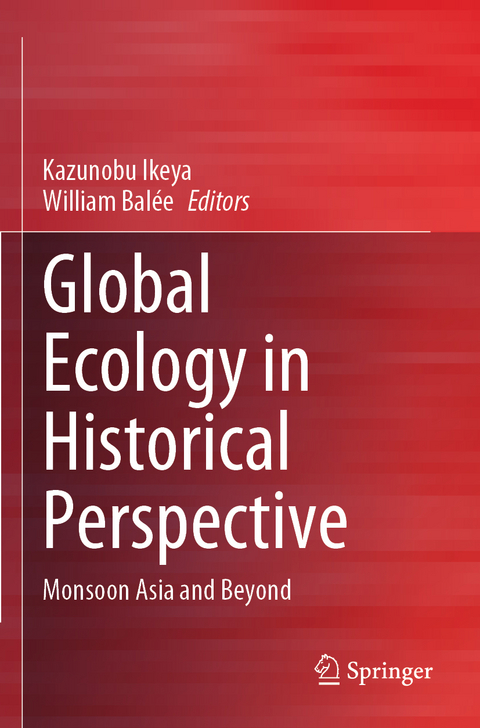
Global Ecology in Historical Perspective
Springer Verlag, Singapore
978-981-19-6559-3 (ISBN)
By showing the regional nature of human-animal and human-plant interactions in Asia, this book provides for the first time a framework for understanding the world's animal and plant-human relationships. It is assumed that the relationships between humans and animals and plants during this period were diverse, including hunting, taming, semi-domestication, and full domestication. At the same time, for regions outside of Asia, the extent to which these diverse relationships were adapted and how diversity was formed is explained from the perspective of historical ecology.
Customers can expect to derive perspectives on the coexistence of human-animal and plant-animal relationships from this book in the near future.
The conservation of rare species, diverse habitats, and biodiversity is a central theme in considering the relationship between modern civilization and the global environment. In post-industrial Japan, one focus has been the protection of iconic animals such as storks, crested ibis, dugongs, and sea turtles, while damage to crops and humans by deer, wild boars, monkeys, bears, and other common animals has become an important social issue. How can the world's 7.7 billion-plus people live in harmony with other species? We would like to get some hints on how to solve the problems we are facing.
Kazunobu Ikeya ProfessorNational Museum of Ethnology, Japan Field of Study: Environmental anthropology, cultural geography Prof. Ikeya received his Ph.D. from Tohoku University in 2003. He has conducted field work among the San in Africa and the Japanese and Chukchi in Northeast Asia. William Balée ProfessorTulane University, USA Field of Study: Cultural anthropology; Amazonia; historical ecology; ethnobiology Prof. Balée received his PhD from Columbia University in 1984. He has conducted fieldwork among Ka'apor, Guajá, Araweté, Tembé, Assurini do Xingu, and Sirionó societies.
Chapter 1: Comparison of Landscape Transformations in the Japanese Archipelago and the Brazilian Amazon.- Chapter 2: Trends for Ethnoecology in the French-Speaking Tropics and Beyond: Origins and Evolution.- Chapter 3: “Back to the Trees!”: Historical Ecology in Amazonia.- Chapter 4: The Changing Mountain Landscapes in Japan: Wild Bear–Human Interactions in the Short Term.- Chapter 5: Undoing Monkey Attraction to the Village: A Food-and-Threat Response to Wildlife Crop-Raiding in Rural Japan.- Chapter 6: Rearing Wild Boar in Okinawa: Thinking About Their Domestication.- Chapter 7: Adaptive Strategies of Cormorant Fishers in Response to Decreased Fishing Area: A case study of Poyang Lake, Jiangxi Province, China.- Chapter 8: Gayal–Human Relationships in the Forests of Bangladesh.- Chapter 9: Bamboo Culture in Monsoon Asia: A Study of the Hmong Farmer in Northern Thailand.- Chapter 10: Use and Knowledge of Sago Palms in Borneo: A Case of the Penan Hunter-Gatherers.- Chapter 11: Taro (Colocasia esculenta) in Asia and the Pacific: Models for Domestication as a Food and Fodder Crop.- Chapter 12: Historical Changes in Human Relationships with Whales: Historical Ecology of Iñupiat and Bowhead Whales in Alaska, USA.- Chapter 13: Historical Ecology of Sea Turtle Fishing by the Indigenous Lowland Peoples of Eastern Nicaragua: a 40-Year Record.- Chapter 14: Sweet Cassava and Bananas in the Peruvian Amazon: Shipibo Cultivation Methods on the Floodplains.- Chapter 15: Constructed Biodiversity, Forest Management, and Use of Fire in Ancient Amazonia: Archaeological Testimony to the Last 14,000 Years of Indigenous History.- Chapter 16: Relations between People, Water, and Domestic Animals in an Ancient Oasis City.
| Erscheinungsdatum | 05.04.2024 |
|---|---|
| Zusatzinfo | 99 Illustrations, color; 37 Illustrations, black and white; XXIV, 304 p. 136 illus., 99 illus. in color. |
| Verlagsort | Singapore |
| Sprache | englisch |
| Maße | 155 x 235 mm |
| Themenwelt | Naturwissenschaften ► Biologie ► Ökologie / Naturschutz |
| Naturwissenschaften ► Biologie ► Zoologie | |
| Sozialwissenschaften ► Ethnologie | |
| Sozialwissenschaften ► Soziologie | |
| Weitere Fachgebiete ► Land- / Forstwirtschaft / Fischerei | |
| Schlagworte | Historical Ecology • Human-animal relationship • Human impact • Human-Plant Relationship • Satoyama |
| ISBN-10 | 981-19-6559-5 / 9811965595 |
| ISBN-13 | 978-981-19-6559-3 / 9789811965593 |
| Zustand | Neuware |
| Informationen gemäß Produktsicherheitsverordnung (GPSR) | |
| Haben Sie eine Frage zum Produkt? |
aus dem Bereich


